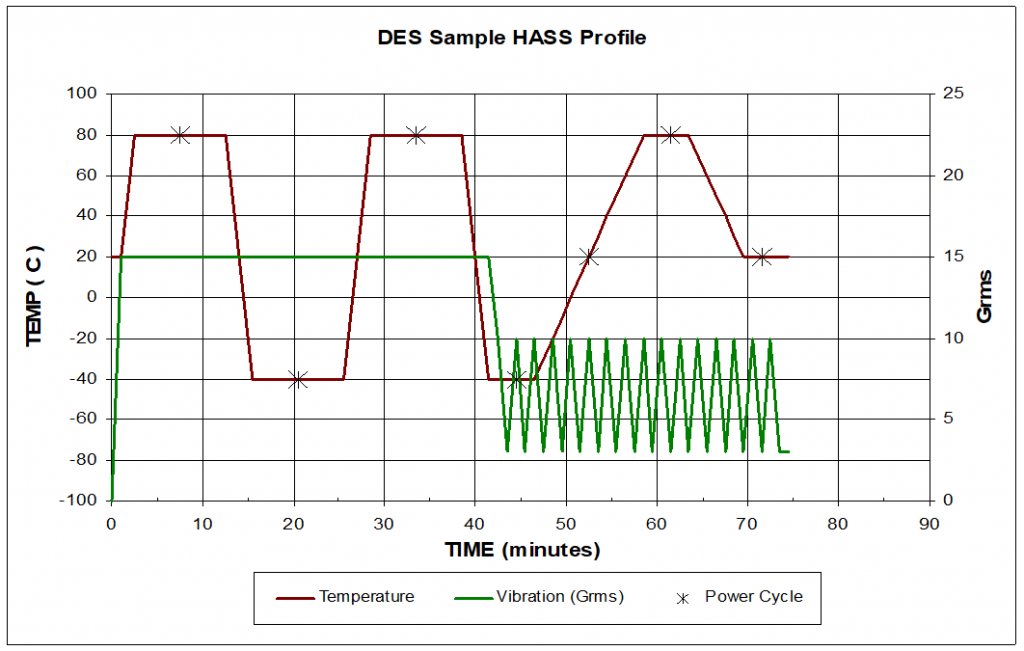HASS is an acronym for Highly Accelerated Stress Screening. HASS is performed during manufacturing on production products or components. It is a screening method used to expose manufacturing defects that would cause a failure in normal field environments including shipping, storage and use.
Two very important concepts to be applied in HASS are:
- HALT must be performed before HASS to produce a robust product design before you enter into a HASS screening program. To learn more about Highly Accelerated Life Testing (HALT), please read our blogs:
What Is HALT (Highly Accelerated Life Testing) And Why Perform HALT?
What Is A Typical HALT Procedure?
What Equipment Is Used For HALT?
What Kind Of Failures Occur During HALT?
Circuit Board HALT Testing Case Study
Rapid HALT – A Cost Effective Alternative to HALT
An Informational Guide to HALT and HASS
- A Proof of Screen (POS) (sometimes called Safety of Screen) must be used to validate the HASS to prove that sufficient life is left for a normal use lifetime.
During HASS, stresses may be higher than normal operation to precipitate defects in a short amount of time, however the stresses are within the capability of the design as proven by the HALT. HASS stresses are also typically more aggressive than those used in traditional Environmental Stress Screening (ESS) which makes HASS a more efficient screen than ESS. HASS screens are typically an hour to a few hours whereas ESS screens may take a day to a few days.
The types of stresses used for HASS are similar to those used in HALT. HASS uses combined temperature cycling, random vibration and electrical loading/monitoring. HASS screens are performed in the same type of chamber that is used for HALT. The vibration in HASS is randomly applied over a broad frequency range producing energy to 10,000 Hz in 6 degrees of freedom.
What is a Typical HASS Profile?
A typical HASS profile used by DES is shown in Figure 1. The first part of the HASS profile (0 to ≈ 40 minutes) is a precipitation screen used to precipitate latent defects. The precipitation screen consists of high levels of steady vibration and temperature rate of changes of approximately 40 – 60 °C/minute. The second part of the HASS profile (40 – 75 minutes) is a detection screen used to detect precipitated defects. The detection screen consists of lower levels of modulated vibration and slower temperature rate of changes of approximately 5 – 10 °C/minute. It is sometimes easier to find intermittent defects during the detection screen because the stress levels are lower and the temperature rate of change is slower.

Figure 1. Sample HASS profile used by DES
Why Use HASS?
- To produce a rugged, reliable product
- To regularly audit or screen your production components to check for and improve manufacturing quality
- To produce a more rugged/reliable product with less field failures and warranty expenses
What are the Benefits of HASS?
HASS screens are shorter than traditional Environmental Stress Screening (ESS) methods. This results in reduced time and cost to screen production. Since the screens are shorter and more aggressive than ESS:
- Defects are typically found sooner
- Problems are corrected faster
- Fewer defects reach the customers’ hands
Overall product quality and manufacturing process control are improved when using HASS. Reliable products lead to happy customers. Happy customers lead to increased profits/market share!
DES has more than 20 years of experience performing HALT/HASS testing on a variety of medical, commercial, industrial and military products. For more information on HASS, HALT or other testing services, contact DES or call 610.253.6637.